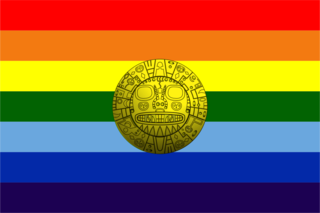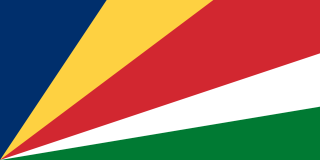 W
WA rainbow flag is a multicolored flag consisting of the colors of the rainbow. The designs differ, but many of the colors are based on the spectral colors of the visible light spectrum. When Isaac Newton first saw a rainbow through a prism, he labeled the colors red, orange, yellow, green, blue, indigo, and violet. However, when not seen through a prism, the color he deemed "blue" is actually blue-green, or cyan, what he called "violet" is today known as dark blue, and "indigo" is a normal blue.
 W
WThe Buddhist flag is a flag designed in the late 19th century as a universal symbol of Buddhism. It is used by Buddhists throughout the world.
 W
WDIY rainbow crossing was a protest movement that emerged in Sydney in 2013. The campaign involved individuals creating rainbow pedestrian crossings in chalk to protest the removal of a temporary rainbow crossing from Oxford Street in Sydney. The temporary crossing was created by the City of Sydney as part of the 35th-anniversary celebration of the Sydney Mardi Gras. When the crossing was to be removed, the community protests and internet activism campaign emerged. In 2013, NSW’s first permanent rainbow crossing was approved and installed on Lackey St, Summer Hill. In 2019 a permanent Sydney rainbow crossing was unveiled in Taylor Square, on the corner of Bourke and Campbell streets.
 W
WThe official flag of Cusco has seven horizontal stripes of color: red, orange, yellow, green, sky blue, blue, and violet. This rainbow flag was introduced to Peru in 1973 by Raúl Montesinos Espejo, in recognition of the 25th anniversary of his Tawantinsuyo Radio station. As the flag's popularity grew, Cusco mayor Gilberto Muñiz Caparó declared it an official emblem in 1978.
 W
WThe Jewish Autonomous Oblast is situated in the Far Eastern Federal District of Russia.
 W
WThe gay pride flag of South Africa is a gay pride symbol that aims to reflect the freedom and diversity of the South African nation and build pride in being an LGBTQ South African. It was registered as the flag of the GLBTI Association of South Africa in 2012 and is not an official national symbol of South Africa.
 W
WThe New Pride Flag is a flag design by Julia Feliz, a two spirit, AfroTaino artist, to integrate the historic and modern-day struggles of the LGBT movements with racism. The design contains the colors of the Trans Pride Flag, to which brown and black diagonal stripes are added, and this is then superimposed on the classic LGBTIQA+ Pride Rainbow Flag.
 W
WThe rainbow flag is a symbol of lesbian, gay, bisexual, transgender (LGBT) and queer pride and LGBT social movements. Also known as the gay pride flag or LGBT pride flag, the colors reflect the diversity of the LGBT community and the "spectrum" of human sexuality and gender. Using a rainbow flag as a symbol of gay pride began in San Francisco, but eventually became common at LGBT rights events worldwide.
 W
WThe national flag of Mauritius, also known as the Four Bands and Les Quatre Bandes, was adopted upon independence, March 12, 1968. It consists of four horizontal bands of equal width, coloured red, blue, yellow, and green. The flag was recorded at the College of Arms in London on 9 January 1968.
 W
WThere have been several designs for a peace flag.
 W
WA Tibetan prayer flag is a colorful rectangular cloth, often found strung along trails and peaks high in the Himalayas. They are used to bless the surrounding countryside and for other purposes. Prayer flags are believed to have originated with Bon. In Bon, shamanistic Bonpo used primary-colored plain flags in Tibet. Traditional prayer flags include woodblock-printed text and images.
 W
WThe flag of Seychelles was adopted on January 8, 1996. The current flag is the third used by the country since its independence from Britain on June 29, 1976. The colours used in the current flag are the official colours of two of the nation's major political parties: the Seychelles People's United Party and the Seychelles Democratic Party.
 W
WThe Wiphala is a square emblem commonly used as a flag to represent some native peoples of the Andes that include today's Peru, Bolivia, and parts of Ecuador, Argentina, Chile and Colombia.